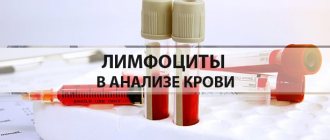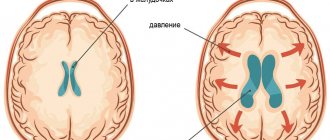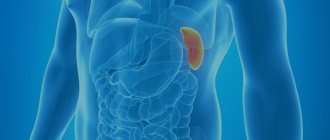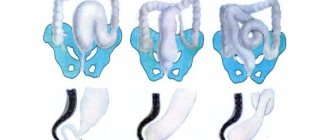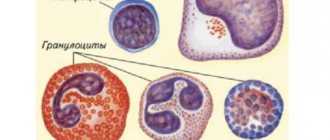What will happen in the video:
1. What are monocytes |
00:22 (in video) 2. Normal monocytes in the blood | 02:49 (in video) 3. Reasons for the increase in monocytes in the blood | 03:42 (in video) 4. Symptoms of increased monocytes in the blood | 06:58 (in video) 5. Increased monocytes in children (monocytosis in children) | 10:39 (in video) Online consultation with infectious disease specialist, allergist-immunologist Natalia Nikolaevna Gordienko
Cost of online consultation: 3500 rubles
Online consultation
During the consultation, you will be able to voice your problem, the doctor will clarify the situation, interpret the tests, answer your questions and give the necessary recommendations.
Read more about blood tests in our article
“Hematological tests: norms and interpretation of results.”
What are monocytes?
A monocyte is a representative of white blood cells. If translated from ancient Greek, then μονος is one, and κύτος is a cell. This is a fairly large cell, which has a large nucleus, slightly eccentrically displaced, and in our body it performs very important functions. To perform its tasks, the so-called janitors or orderlies, it is equipped with special devices.
This cell can have amoeboid movement, it can move independently, like an amoeba, in the liquid part of the blood, and it can have transnasal movement. those. leave its stay in the bloodstream through the thin wall of the blood vessel and, accordingly, rush into certain tissues. Performing its function as an orderly, it has such a powerful property as chemotaxis (the motor reaction of microorganisms to a chemical irritant) and can rush precisely to the sites of inflammation. There, where there are many destroyed cells, where there may be dead bacteria, viruses, dead cells of the body.
Let’s say there is a flu-like condition, and during this period there is a lot of destruction of the epithelial cells of the nasopharynx or oropharynx. And monocytes, during the flu period, will rush there and try to utilize dead cells. By enveloping fairly large pieces of destroyed bacterial cells and digesting them, they will prepare the tissue for reparative processes (recovery processes). They must clean out the field, and in this field, after eliminating the source of inflammation, young, healthy cells will then grow.
The norm of monocytes in the blood
To determine the level of cells, the patient is prescribed a general clinical blood test, which determines how many elements are present in a unit of its volume. Normally, an adult should have 3-11 monocytes per 100 leukocytes. To find out the content of all white cells, a leukogram is done - an advanced analysis that determines the leukocyte formula.
The decoding may indicate the absolute content - monocytes abs or monocytes mono - percentage.
How many leukocyte cells should be in the analysis of adults and children can be seen in the table.
| Category of people | Quantity %. |
| Children | |
| In a newborn baby | 3 -12 |
| Two weeks old | 3 — 15 |
| From 2 weeks to 12 months | 4 -10 |
| From 1 to 2 years | 3 -10 |
| From 2 to 16 years | 3 — 9 |
| Adults | |
| In men | 3 — 11 |
| Among women | 3-11 |
| During pregnancy | |
| 1st trimester | 3,9 |
| 2nd trimester | 4,0 |
| 3rd trimester | 4,5 |
Causes of increased monocytes
Out of the blue, just like that, the number of monocytes does not increase. There are certain reasons for this. I want to tell you the main diseases and conditions in which the number of monocytes in the blood will increase.
- Of course, tuberculosis, including extrapulmonary forms of tuberculosis, will come first. It is he who will cause this monocytosis. Unfortunately, today the number of tuberculosis of the extrapulmonary form is beginning to increase widely: kidneys, intestines, skin, spine, lymph nodes, cases of tuberculosis of the lymph nodes have especially increased. In all these conditions, in any form of tuberculosis, a person will always have an increase in the number of lymphocytes.
- Syphilitic lesion. Syphilis is also a systemic disease, and it will also cause monocytosis or an increase in the number of lymphocytes.
- Autoimmune diseases. First of all, diseases of an autoimmune nature of connective tissues: systemic lupus erythematosus, rheumatoid conditions, rheumatoid arthritis, periarthritis nodosa. When immune inflammation occurs in connective tissues. In these conditions there will also be monocytosis.
- Problems of the digestive tract, in particular ulcerative colitis, inflammation of the small intestine, Crohn's disease - these are conditions when the number of lymphocytes in the blood will also increase.
- Cancerous tumors. They will also have monocytosis.
- The recovery period after any inflammatory process of infectious origin. What does it mean? Any infectious disease can cause a state of monocytosis. And if monocytosis develops in diseases not related to tuberculosis or syphilis, then an increase in monocytes will indicate that the infectious process has entered its final stage. In other words, monocytes, having activated into phagocytes, indicate that the inflammatory process is entering its final stage.
- Oddly enough - stress. They can cause monocytosis. It is stress, through a violation of psycho-emotional balance, through the pituitary-hypothalamus zone, through the adrenal systems, that can cause an increase in monocytes.
- Oncological diseases such as lymphomas or Kharchenko's disease. They can also provoke an increase in the number of lymphocytes.
What does a low monocyte count indicate?
A low monocyte count, also known as monocytopenia, may indicate HIV infection, immunodeficiency including Monomak syndrome, AIDS, bone marrow aplasia, leukemia or a consequence of chemotherapy or radiation therapy, severe stress, or certain medications.
If monocytopenia continues for a long time, it can lead to a decrease in all blood counts: red blood cells, leukocytes (white blood cells) and platelets. This condition is called pancytopenia.
Therefore, if there is any deviation from the norm in the monocyte test result, you should consult your doctor. If a history of infection is causing the change in monocyte count, the test should be repeated after 2 to 4 weeks.
In other cases, it may be necessary to complete the diagnosis with imaging tests, a urinalysis, and other blood tests such as CRP or ASO levels.
Symptoms
How will a person feel, how will he feel? What should motivate a person to go and take a blood test? What symptoms might he have that could lead to an increase in monocytes in the blood?
- This could be causeless weight loss.
- Decreased or complete absence of appetite.
- Increased fatigue. Unreasonable weakness. It seemed like he had gotten enough sleep, he didn’t seem to be overtired, he seemed to be resting, but in the morning he got up and had no strength. This groundless weakness requires mandatory monitoring of blood tests.
- Anxiety, panic attacks, depression, or psycho-emotional agitation. This should also encourage a person to go and do a detailed blood test.
- Irritability, apathy, drowsiness - any disturbance in the psycho-emotional state can cause changes in the peripheral blood.
- Sudden refusal of meat food, even to the point of disgust for meat food. As a rule, monocytosis will be present in a detailed blood test.
- Gastrointestinal disorders: bloating, rapid motility, bowel dysfunction, both constipation and diarrhea, increased secretion of mucus in feces.
- A dry, prolonged cough, sometimes streaked with blood, with scanty sputum.
- Joint and muscle pain in the back and legs. This also requires decoding and examination.
- Specific rashes on the skin and mucous membranes can also be a condition in which there will be monocytosis or an increase in the concentration of monocytes in the blood.
- Presence of rashes on the genitals.
It must be said that all of the above reasons can be disturbing, both individually and collectively, together. Several symptoms unite into entire syndromes. I want to emphasize that an increase in the number of monocytes in the blood in itself is not a diagnosis. This is a state of peripheral blood cells of the immune system, which indicates that not everything is in order in the “state”, and this requires mandatory examination, requires careful attention and further decoding.
Preparing for analysis
Because the monocyte count is part of the blood test, the preparation for it is the same as for other basic laboratory tests.
The patient should present to the laboratory on an empty stomach with a minimum 12-hour break from eating. 2-3 days before the examination, it is worth limiting the amount of intense exercise and the use of stimulants. You must inform the referring physician about all medications and dietary supplements you are taking, as they may affect the results obtained.
Monocytosis in children
Separately, I want to talk about monocytosis in children. This has recently become a fairly common condition, and parents and, unfortunately, not even medical workers always know what to think about with monocytosis and what pathological causes can cause an increase in the number of monocytes in children.
- Firstly, these are diseases caused by bacteria, fungi and viruses. In principle, any of these “friends” can cause an increase in monocytes in the child’s blood.
- Infection with worms. This reason can even be put in first place in children's practice.
- Inflammatory processes in the gastrointestinal tract. And that condition of the gastrointestinal tract, which we call: intestinal dysbiosis, which is also not a diagnosis, but it is the microbiota that can determine the concentration of monocytes and cause monocytosis.
- Food poisoning. And any other poisoning can cause monocytosis in a child’s body.
- Allergic reactions in a child. If we talk about young children, then this is predominantly a genetically determined food allergy. If we talk about older children, then these may be allergic reactions associated with the same parasitosis, helminthic infestations, protozoan infections, or the consumption of food products containing a lot of preservatives, allergens, all kinds of stabilizers, etc., that is, not Completely suitable food for a child.
- Oncological diseases of the blood. Of course, they can also cause monocytosis, and, first of all, these are leukemia and lymphoma.
- Autoimmune pathology of children.
- Rheumatoid arthritis or juvenile rheumatoid arthritis.
- Systemic lupus erythematosus.
- Crohn's disease.
- Infectious processes after surgical interventions can also cause monocytosis, and this will be one of the body’s protective reactions.
If we talk about monocytosis in pediatric practice, then, of course, first of all it will be associated with acute respiratory viral infections, diseases of an infectious nature, and bacterial diseases of the gastrointestinal tract. Therefore, on the one hand, there is no need to be afraid of monocytosis, but on the other hand, this is a blood indicator that can indicate some serious, still hidden problems that are not clearly manifested clinically. And this is a reason to conduct more in-depth research on a specific person.
That’s basically all I wanted to tell you about monocytes. If you have any questions, you can write to us or ask them in the comments. And if everything is clear to you, I was glad to give you this information. Come see us if the need arises and stay healthy.
Diagnostic value of simultaneous increase in other types of leukocytes
To make a diagnosis in a blood test, it is important to detect not only elevated monocytes, but also other cells of the leukocyte series. Together they:
- indicate the stage of the disease;
- determine the prognosis;
- confirm the type of infectious agent;
- determine the degree of loss of immunity.
Let's look at the most common reactions of blood cells.
Monocytes + lymphocytes
When monocytes and lymphocytes are elevated, an acute viral infection should be suspected: influenza, respiratory disease, measles, rubella, chickenpox. Against this background, a decrease in neutrophils is observed.
It is clear to the doctor that it is necessary to prescribe antiviral drugs.
This is what different types of leukocytes look like under a microscope
Monocytes + eosinophils
For elevated monocytes and eosinophils, the necessary conditions are usually allergic reactions and parasitic infection (chlamydia and mycoplasma).
A distinctive symptom in patients is a long, painful dry cough in the absence of wheezing in the lungs and other clinical manifestations.
Monocytes + basophils
Basophils are fast-reacting cells; they manage to approach the source of infection while others are still “considering the information received.” If monocytes and basophils increase, it is necessary to exclude the influence of long-term treatment with hormonal agents.
The growth of basophils always accompanies an increase in macrophages and lymphocytes. They act by producing serotonin, histamine and other substances that increase inflammation.
